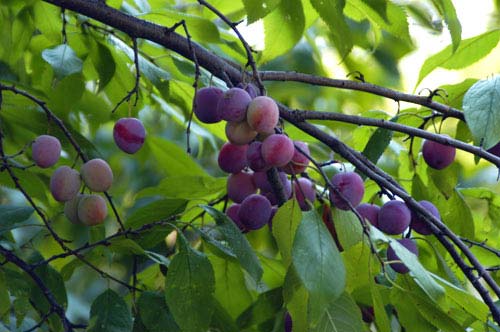As plum season coincided with the holy month of Ramadan this year, the soft, sweet and sour fruit is fading fast from the shelves. Ruwa Shah traces the traditional cultivation belts, market and economy of the plum in Kashmir.
On the southern end of Rawalpora, an uptown plush locality in the outskirts of Srinagar city, adjacent to the palatial residential bungalows, Aziz Sofi, 75, owns 8 kanals of plum orchards.
Aziz who is into plum cultivation for more than four decades now takes care of his orchards personally. Aziz is helped by his brother Rahim Sofi in maximizing the yield.
Rawalpora, which has been entirely carved out of plum rich orchards is a contrast between vast farmlands on one side and modern concrete houses on the other side.
As one crosses the high fenced residential houses to reach vast open fields a sense of calm sets in. Next to his big plum orchard, in a small grocery shop sits seventy-year-old Abdul Aziz Mir. He has been cultivating plums on four kanals of his farmland since last 30 years. Mir harvests around 350 boxes of plum every year from his orchard which he says hardly earns him any profits.
“I do not earn much out of this just Rs 15,000 per season that too after lot of hard work,” says Mir.
Rawalpora and Machuwa are the oldest and largest belts of plum cultivation in Kashmir. A large number of people in these areas are associated with plum cultivation since ages.
“This area is famous for plum production. Almost everybody here owns a plum orchard. Though size of the farmland might differ from household to household but everyone owns plum farms here,” says Mir confidently.
One of the three main varieties produced in Kashmir is centrose plum. Traditionally it has been a great source of income for plum growers in the valley. This ‘sour-sugary’ fruit is grown in larger parts of Srinagar and many other districts. The other two varieties i.e. silver plum and Chogandhra are grown on a small scale only.
Since 2007, the growth and production of plum has simultaneously increased. According to the data provided by the Department of Horticulture, the total production of plum has gone up from 7810 metric tonnes in 2007 to 8102 metric tonnes in 2012. The area under plum cultivation has also increased from 3841 hectares to 4341 hectares of land respectively in the same period.
District Budgam in central Kashmir is one of the largest producers of plum. It has about 953 hectares of land under plum cultivation producing around 1616 metric tonnes in 2012.
Akhtar Hussain, deputy director, department of horticulture told Kashmir Life that government is planning to provide incentives to the growers under the central scheme of HMNEH for stone (drupe) fruits.
Currently, the incentives provided by the government include raw material for fencing of orchards and cultivation.
“In last few years the overall growth and production of plum have increased. There is no major downfall. In fact we have seen huge growth in plum cultivation and harvest,” he added.
The flowering period of the fruit is very critical for a healthy crop. This delicate fruit easily falls and gets injured (stained) when the weather does not remain favourable.
Bashir Ahmad Bashir, president fruit market, Parimpora said that the production was less this year. “This year the overall production of plum was almost half than what we had the previous year. It was due to the unfavourable weather conditions,” he told Kashmir Life.
Whereas Akhtar said, “Due to the large fluctuations in temperature in March and April this year (which is the flowering period of the fruit), the production may have fallen.”
Bashir who oversees most of the production chain says that only 7 lakh boxes of plum were produced this year. Each box weights around 6 kilograms.
On an average, each plum box is sold between Rs 150 and 300, depending upon the quality and season.
A bulk of plum from Parimpora market is sent directly to markets in Delhi and Punjab from where it gets distributed to other markets. “The limited demand for plum locally is forcing cultivators to send their produce outside Kashmir,” says Bashir. “The prices have gone up this year because of less production,” he adds.
Plum is available in the market for less than two months i.e. from mid July to ending August.
“Plum is a highly delicate fruit. It has a very limited shelf life too. In order to increase its shelf life, farmers harvest plum in mid July when it is half ripened,” said Bashir.
Because of its sour taste, plum is not only utilised raw as a fruit. It is also used to make pickle and jam. According to a recent research plum contains antioxidants and phytonutrients, which helps body to fight diseases like cancer and heart ailments.
(Ruwa Shah is recipient of Jawhara Shawl scholarship)
















